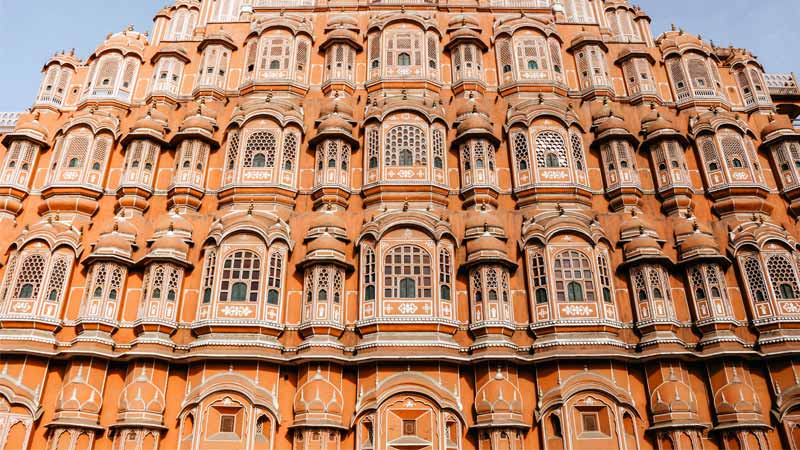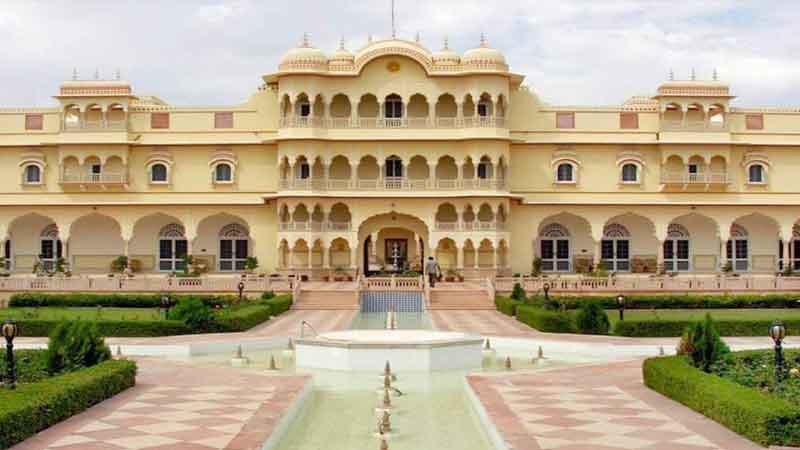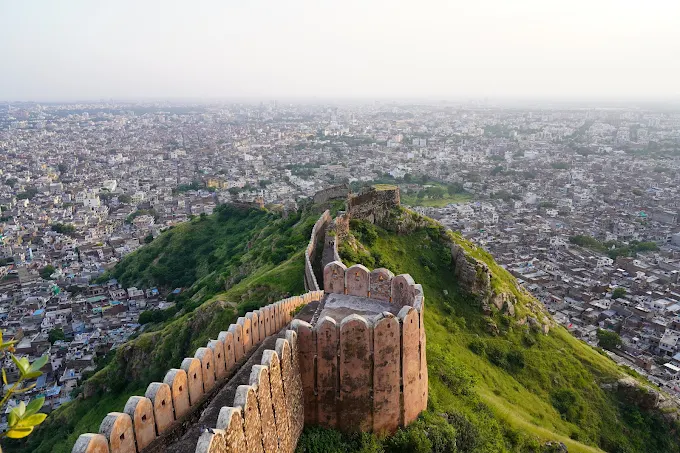

Overview
Jaipur, the pink city, is the lively capital of Rajasthan, India. It is known as the Pink City because of its famous rose-colored buildings. This tradition began in 1876 when Maharaja Ram Singh wanted to welcome the Prince of Wales. Jaipur was founded in 1727 by Sawai Jai Singh II.
It is India’s first planned city. Vidyadhar Bhattacharya designed it using Vastu Shastra principles. As a key part of the Golden Triangle (Delhi, Agra, Jaipur), it is a popular tourist spot. It combines royal history, rich culture, and beautiful architecture. Jaipur has a population of over 3.1 million as of 2011. It is one of India’s major cities, blending tradition and modern life.
Top Attractions
Amber Fort (Amer Fort)
A UNESCO World Heritage Site, Amber Fort, built in 1592, is a stunning hilltop palace complex 11 km from Jaipur. Known for its Rajput and Mughal architecture, it features the dazzling Sheesh Mahal (Mirror Palace) with intricate mirror mosaics. The fort’s strategic location in the Aravalli Hills and its panoramic views of Maota Lake make it a must-visit. The sound and light show in the evening narrates its storied past.
City Palace
Located in Jaipur city’s heart, the City Palace is a magnificent complex blending Rajput, Mughal, and European styles. Home to the royal family, it includes Chandra Mahal and Mubarak Mahal, housing museums with royal artifacts, textiles, and weaponry. The Peacock Gate and sprawling courtyards are architectural highlights.
Hawa Mahal
The iconic Hawa Mahal, or Palace of Winds, built in 1799, is a five-story pink sandstone marvel with 953 jharokhas (windows) designed for royal women to observe street life discreetly. Its intricate latticework glows at sunrise, making it a photographer’s paradise.
Jantar Mantar
A UNESCO World Heritage Site, Jantar Mantar is an 18th-century astronomical observatory built by Jai Singh II. Featuring 19 precise instruments, including the world’s largest stone sundial, it offers a fascinating insight into ancient Indian astronomy.
Nahargarh Fort
Perched on the Aravalli Hills, Nahargarh Fort, built by Sawai Jai Singh II, offers breathtaking views of Jaipur city. The Madhvendra Palace within, designed for the king’s queens, features floral motifs and murals. Visit at sunset for a glowing panorama of the Pink City.
Jaigarh Fort
Connected to Amber Fort by a hidden tunnel, Jaigarh Fort is a red sandstone stronghold housing the Jaivana Cannon, the world’s largest cannon on wheels. Its Persian-style gardens and views of Amer Fort and Maota Lake add to its allure.
Jal Mahal
Situated in Man Sagar Lake, Jal Mahal appears to float on water, with only one of its five stories visible. Though inaccessible, its picturesque setting is best viewed from Nahargarh Fort, showcasing Jaipur’s architectural ingenuity.
Cultural Experiences of Jaipur the pink city
Markets and Shopping
Jaipur the pink city is a shopper’s haven with vibrant bazaars like Johari Bazaar (jewelry), Bapu Bazaar (textiles), Tripolia Bazaar (bangles and carpets), and Chandpole Bazaar (marble statues). The city is famous for blue pottery, block-printed fabrics, and hand-knotted rugs. Visit Rajasthali on MI Road for authentic Rajasthani crafts. The Amrapali Museum and Museum of Gem and Jewellery showcase Jaipur’s legacy as a gem and jewelry hub.
Cuisine
Jaipur’s culinary scene reflects Rajasthan’s diversity. Savor dishes like Dal Baati Churma (lentil curry with ghee-infused dumplings), Laal Maas (spicy mutton curry), Gatte ki Sabzi, and Ker Sangri. Sweet treats include Ghevar, Mawa Kachori, and Chauguni ke Laddu. Masala Chowk offers a variety of street foods, while Chokhi Dhani provides an authentic Rajasthani dining experience with cultural performances.
Festivals
Jaipur’s festivals are vibrant celebrations. The Jaipur Literature Festival (January/February) is the world’s largest free literary event. Other festivals include the Kite Festival (January), Gangaur (March-April), Teej (monsoon season), and Dhulandi (Holi), where the Pink City comes alive with colors, music, and dance like Ghoomar and Chari.
Cultural Sites
The Jawahar Kala Kendra promotes Rajasthani art through exhibitions and performances, while the Museum of Legacies in Kishanpole Bazaar displays textiles, jewelry, and stoneware. The Akshardham Temple in Vaishali Nagar and Jagat Shiromani Temple in Amer, dedicated to Lord Krishna and Vishnu, showcase intricate carvings and spiritual serenity.
Sights
Map
Info
Practical Information
Best Time to Visit
October to March offers pleasant weather (15°C–30°C), ideal for sightseeing. Summers (April–June) are hot, with temperatures reaching 49°C, while monsoons (July–September) bring heavy rains, though flooding is rare.
Getting There
Jaipur International Airport (Sanganer Airport) connects to major cities like Delhi, Mumbai, and international destinations like Dubai and Singapore. The city is well-linked by rail, with trains like Shatabdi and Rajdhani connecting to Delhi, Agra, and other cities. National Highways 48, 52, and 21 ensure easy road access, with RSRTC buses operating from major cities.
Getting Around
Navigate Jaipur using auto-rickshaws, cycle rickshaws, or app-based cabs like Ola and Uber. Jaipur City Transport Services Limited (JCTSL) operates over 400 buses. For a royal experience, try an elephant ride to Amber Fort’s courtyard (Rs. 1100 for two). The Jaipur BRTS and Ring Road ease city travel.
Accommodation
Jaipur offers a range from luxury heritage hotels like Rambagh Palace and Jai Mahal Palace to budget guesthouses in the old city. Alsisar Haveli and Samode Haveli provide authentic Rajasthani ambiance. Book early during peak season (October–March).
Unique Experiences
-
Hot Air Balloon Rides: Soar over Jaipur’s forts and lakes for stunning aerial views.
-
Sound and Light Shows: Experience Amber Fort’s history through its evening show or the Amar Jawan Jyoti show celebrating Rajasthan’s warriors.
-
Jhalana Safari Park: Spot leopards, panthers, and birds in this 1978-hectare reserve.
-
Raj Mandir Cinema: Watch a Bollywood movie in this iconic, luxurious single-screen theater.
-
Sculpture Park at Nahargarh: Explore contemporary art amidst historic surroundings.
Tips for Travelers
-
Wear comfortable shoes for exploring forts and markets.
-
Bargain politely in bazaars, but expect fair prices for quality crafts.
-
Stay hydrated and use sunscreen, especially in summer.
-
Respect local customs at temples and palaces, such as removing shoes.
-
Visit early to avoid crowds at Amber Fort and Hawa Mahal.
-
Check out the Rajasthan Festival (March) for a vibrant cultural immersion.
Why Visit Jaipur?
Jaipur, painted pink to symbolize hospitality, is a city where history meets vibrancy. Its palace complexes, world heritage sites like Amber Fort and Jantar Mantar, and bustling markets make it a cultural gem. Whether you’re exploring the architectural marvels of Sawai Jai Singh II, savoring Rajasthani cuisine, or immersing yourself in festivals, Jaipur offers an unforgettable journey into India’s royal past and dynamic present.






















